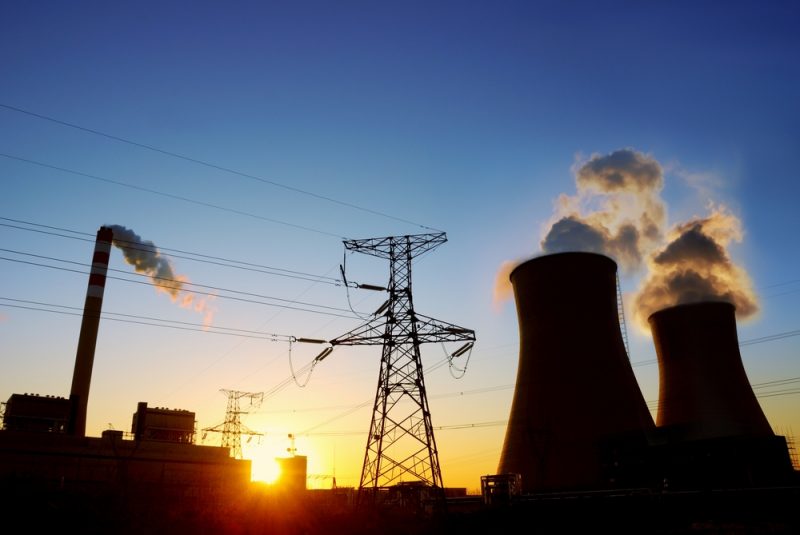DOE’s grid reliability study recommends federal supports for coal, nuclear

The resilience of America’s electricity grid relies upon a combination of factors, including specific actions across several federal agencies to support coal and nuclear power, according to a new study from the U.S. Department of Energy (DOE).
The widely anticipated 187-page Staff Report to the Secretary on Electricity Markets and Reliability,
released late Aug. 23, is “long overdue,” said Energy Secretary Rick Perry, who requested the study in an April 14 memorandum to his staff.
The federal government has failed to keep up with the massive industry changes taking place across the nation, Perry wrote in the report’s cover letter. “This report examines the evolution of markets that has occurred over the last [15] years. Policy makers and regulators should be making decisions based on what
the markets look like today, not what they looked like years ago,” the secretary wrote.
Toward that end, the report evaluated the status of the nation’s electricity system, but more importantly tried “to exercise foresight to help ensure a system that is reliable, resilient, and affordable long into the future,” the report stated.
Specifically, the report analyzed what DOE staff defined as baseload generation power plants, which include most nuclear, coal and natural gas steam generators, and assessed the factors contributing to power plant retirement trends during 2002 to 2017.
“The biggest contributor to coal and nuclear plant retirements has been the advantaged economics of natural gas-fired generation,” according to the report. Translation: low natural gas prices are to blame.
Also cited as contributing factors were low growth in electricity demand, the ongoing rise of variable renewable energy (VRE) resources—like wind and solar—and the regulation-driven cost increases tied to meeting compliance rules or license renewal, for instance.
And because electricity will continue growing slowing through 2030, the study predicted, VRE generation over the same period could roughly double in hours.
“Based on these trends, unless natural gas prices or electricity demand rise significantly faster than projected, the economic conditions of baseload generators are not projected to change significantly in the near term,” the study said.
Interestingly, several topics were listed as being “topics beyond the scope of this study,” including cybersecurity.
“While cybersecurity is a significant concern and top priority, it is not addressed in this report because it is the subject of an upcoming joint report between DOE and the Department of Homeland Security being prepared in response to Executive Order No. 13800, Strengthening the Cybersecurity of Federal Networks and Critical Infrastructure,” according to the report.
Market point
Among its highlighted findings central to protecting the long-term reliability of the U.S. electric grid, DOE staff found that wholesale markets are functioning as intended “despite pressures from flat demand growth, Federal and state policy interventions, and the massive economic shift in the relative economics of natural gas compared to other fuels,” the report said.
However, market design may be inadequate given whatever challenges lie ahead, particularly from VRE, which will decrease wholesale energy prices “independent of effects of the current low natural gas prices,” the report said.
“This would put additional economic pressure on revenues for traditional baseload (and non-baseload) resources)” so further market study and reform is needed “to address future services essential to grid reliability and resilience.”
Edison Electric Institute (EEI) President Tom Kuhn said in a statement today that it’s important for DOE to examine key factors that can enhance the resilience of the energy grid.
“While we are still thoroughly reviewing the study, EEI has long advocated that our customers are best served by public policies that promote a balanced and diverse energy mix, which includes both traditional and renewable energy sources, and that also recognize the vital role 24/7 energy sources play in sustaining a secure, reliable and resilient energy grid,” Kuhn said.
Policy advice
The report provided seven policy recommendations, some within the scope of DOE’s oversight, others falling under other government agencies or private organizations. Generally, some reflect the Trump administration’s pro-coal industry stance and anti-Clean Power Plan of the Obama administration.
For instance, the recommendations included:
- The Environmental Protection Agency should ease permitting requirements for new investments at coal-fired plants;
- The DOE should speed up and reduce costs for licensing and permitting of grid infrastructure such as nuclear, hydro, coal, advanced generation technologies and transmission, while also reducing regulatory burdens for generation and gas and electricity transmission infrastructure;
- The DOE also should assist other federal agencies in carrying out Executive Order 13783, which calls for rescinding certain energy and climate-related policies, reports, and regulations;
- The Nuclear Regulatory Commission should ease safety requirements for new investments at coal-fired plants; and
- The Federal Energy Regulatory Commission should compensate grid participants for maintaining the reliability of the power grid.
Kuhn said that EEI thinks it’s important to value investments in more robust infrastructure while maintaining a diverse energy mix that eliminates single points of failure.
“Whether to limit impacts from inevitable storms or natural events or to prepare for malicious cyber or physical attacks, supporting a resilient energy grid is an investment in national and economic security,” he pointed out.
Additionally, Perry noted that “certain regulations and subsidies are having a large impact on the functioning of markets, and thereby challenging our power generation mix.”
Therefore, he said, policymakers should consider their intended and unintended effects and work closely at the federal and state levels to address the issues that impact grid reliability and resilience.
“America is also fortunate to have a variety of fuel sources. We need to consider how to use each effectively while recognizing our differences and unique state and regional circumstances,” Perry wrote in the report’s cover letter, in which he advocated an “all-of-the-above approach.”
“We also need to recognize the relationship between resiliency and the price of energy,” he wrote. “Customers should know that a resilient electric grid does come with a price.”
